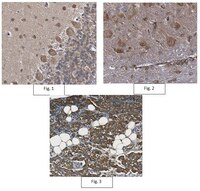ABN1009 Sigma-AldrichAnti-TRPA1 Antibody
Anti-TRPA1 Antibody is an antibody against TRPA1 for use inWestern Blotting and Immunohistochemistry.
More>> Anti-TRPA1 Antibody is an antibody against TRPA1 for use inWestern Blotting and Immunohistochemistry. Less<<Recommended Products
Přehled
| Replacement Information |
|---|
Tabulka spec. kláve
| Species Reactivity | Key Applications | Host | Format | Antibody Type |
|---|---|---|---|---|
| R, H, M | WB, IHC | Rb | Affinity Purified | Polyclonal Antibody |
| References |
|---|
| Product Information | |
|---|---|
| Format | Affinity Purified |
| Presentation | Purified rabbit polyclonal in buffer containing 0.1 M Tris-Glycine (pH 7.4), 150 mM NaCl with 0.05% sodium azide. |
| Quality Level | MQ100 |
| Physicochemical Information |
|---|
| Dimensions |
|---|
| Materials Information |
|---|
| Toxicological Information |
|---|
| Safety Information according to GHS |
|---|
| Safety Information |
|---|
| Storage and Shipping Information | |
|---|---|
| Storage Conditions | Stable for 1 year at 2-8°C from date of receipt. |
| Packaging Information | |
|---|---|
| Material Size | 50 µg |
| Transport Information |
|---|
| Supplemental Information |
|---|
| Specifications |
|---|
| Global Trade Item Number | |
|---|---|
| Katalogové číslo | GTIN |
| ABN1009 | 04055977161878 |
Documentation
Anti-TRPA1 Antibody MSDS
| Title |
|---|
Anti-TRPA1 Antibody Certificates of Analysis
| Title | Lot Number |
|---|---|
| Anti-TRPA1 - 3174763 | 3174763 |
| Anti-TRPA1 - 3229375 | 3229375 |
| Anti-TRPA1 - 3256600 | 3256600 |
| Anti-TRPA1 - 3594289 | 3594289 |
| Anti-TRPA1 - 3936227 | 3936227 |
| Anti-TRPA1 -Q2559154 | Q2559154 |
| Anti-TRPA1 Polyclonal Antibody | 2953746 |
| Anti-TRPA1 Polyclonal Antibody | 2927498 |
| Anti-TRPA1 Polyclonal Antibody | 3043517 |
| Anti-TRPA1 Polyclonal Antibody | 2879526 |
Technical Info
| Title |
|---|
| White Paper: Further considerations of antibody validation and usage. |








